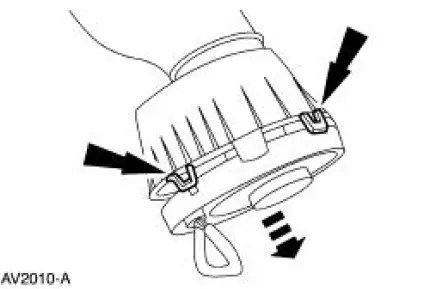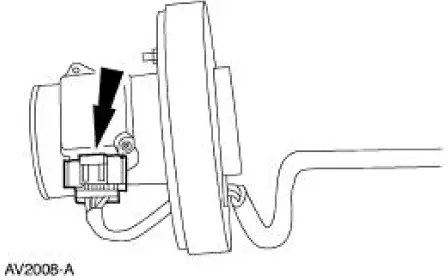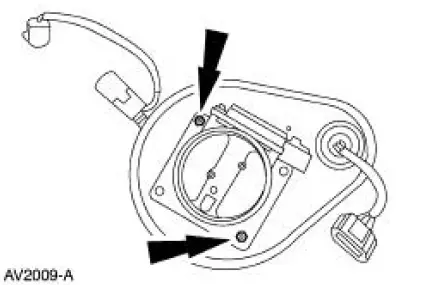Ford Mustang (1999-2004) Service Manual: Mass Air Flow (MAF) Sensor - 3.8L
Removal
CAUTION: The mass air flow (MAF) sensor hot wire sensing element and housing are calibrated as a unit and must be repaired as a complete assembly. Do not damage the sensing element (internal to housing) or possible failure to the mass air flow sensor may occur.
1. Disconnect the battery ground cable. For additional information, refer to Section.
2. Remove the air cleaner and duct assembly. For additional information, refer to Section.
3. Release the four tabs and remove the mass air flow (MAF) sensor.

4. Disconnect the connector.

5. Remove the mass air flow sensor (MAF).
- Remove the nuts and the MAF sensor.

Installation
1. To install, reverse the removal procedure.
 Engine Coolant Temperature (ECT) Sensor - Mach I
Engine Coolant Temperature (ECT) Sensor - Mach I
Material
Item
Specification
Pipe Sealant with Teflon
D8AZ-19554-A
WSK-M2G350-A2
Removal and Installation
1. Remove the air intake scoop. For additional information, refer to
S ...
 Mass Air Flow (MAF) Sensor - 4.6L (2V)
Mass Air Flow (MAF) Sensor - 4.6L (2V)
Removal
CAUTION: The mass air flow (MAF) sensor hot wire sensing
element and housing are
calibrated as a unit and must be repaired as a complete assembly. Do not
damage the sensing
element ...
Other materials:
Status bars
The top status bar shows the
current mode, exterior temperature,
time and display icons if you have
enabled Bluetooth or other options.
The bottom status bar shows the
Home icon and may show the
current driver and passenger
selected temperatures, fan speed a ...
Underbody Misalignment Check
Underbody Dimensions
1. Underbody dimensions tolerances are +- 3.175 mm (0.125 in). Reference
dimensions are not
controlled dimensions. Reference points are +- 4.76 mm (0.1875 in). All underbody
dimensions
are detailed to the centerline of existin ...
Oil Pump Screen and Pickup Tube
Removal and Installation
1. Remove the oil pan (6675). For additional information, refer to Oil
Pan in this section.
2. Remove the oil pump screen cover and tube (6622) and discard the gasket.
1. Remove the nut.
2. Remove the two bolts.
3. Remov ...
